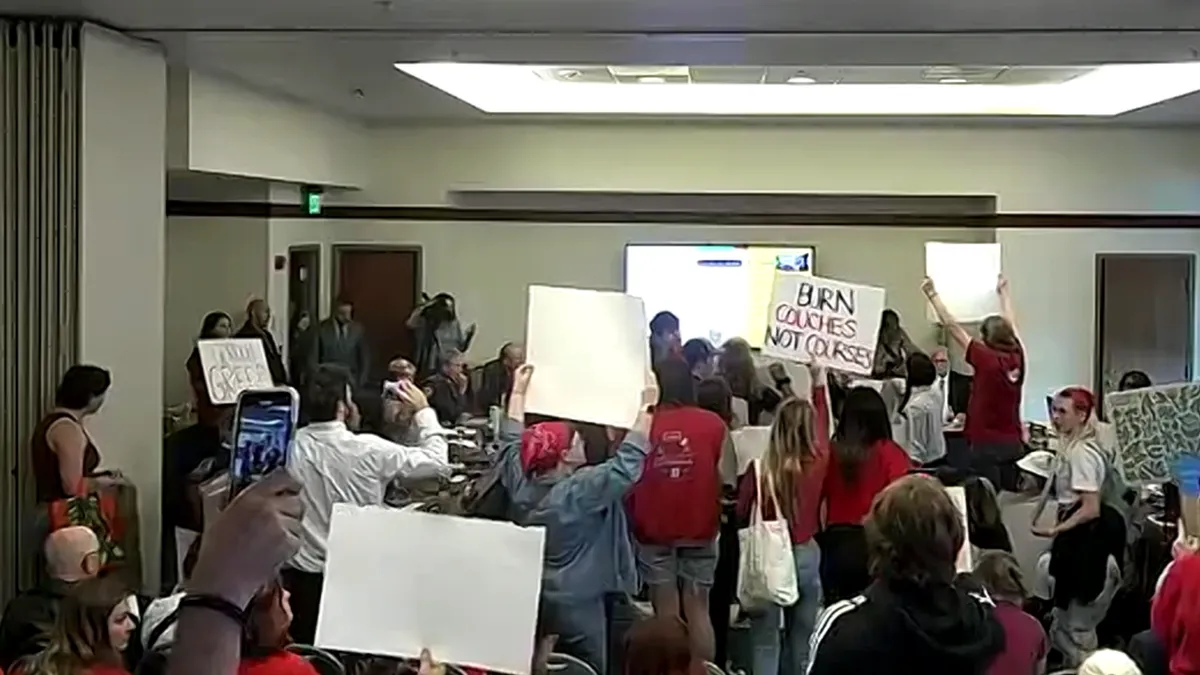Dive Brief:
- West Virginia University will eliminate 28 degrees and roughly 140 faculty positions, austerity measures that critics call unprecedented for a public flagship with an R1 designation.
- WVU’s board of governors signed off on the cuts — 8% of the institution’s academic offerings — during a meeting Friday that protestors repeatedly interrupted. The governors largely approved recommended cuts WVU’s provost made last month. The board only deviated to allow three departments to keep a couple of faculty positions that were due to be axed.
- The vote came despite vehement pushback from faculty, students and alumni. Institution leaders said they were necessary in the face of a $45 million budget deficit.
Dive Insight:
President E. Gordon Gee has said the public flagship institution’s deficit could skyrocket to $75 million in the coming years. He has been the driving force behind a broad restructuring of the university’s academic programs and finances, an attempt to cut costs.
This has made him the subject of intense criticism, with many protesters at Friday's meeting carrying signs calling for his removal as president.
One person, holding a sign that read "This isn't the WVU that I fell in love with," began to cry following the board's approval.
WVU faculty members gave Gee a vote of no confidence earlier this month, saying he had not “fully and honestly” disclosed how the deficit emerged. They argued the administration caused the budgetary gap through financial mismanagement and poor planning and decisionmaking.
Before the vote, Gee had already announced plans to leave the presidency once his contract expires in June 2025 and teach at WVU’s College of Law.
Earlier this week, some West Virginia lawmakers expressed concern that Gee’s “Academic Transformation” plan would endanger the university’s R1 status, a designation conferred by the Carnegie Classification system to colleges that practice the highest level of research activity.
Fred King, WVU’s vice president for research, pushed back on those critiques Friday.
“The changes that we're going through at this university align precisely with where Carnegie sees the future of research universities in the United States,” he said prior to the vote. “I can assure you, if I thought that academic transformation was threatening the things that we have built over this long period of time, I would be the first to be fighting against it.”
During the meeting, dozens of protestors shouted down the governors as they attempted to begin voting on the provost's recommendations. A majority of the demonstrators dispersed after the board chair threatened to have them removed.
One of the biggest points of contention has been the cuts to the university's language offerings.
Under the provost's initial recommendations, WVU had intended to eliminate all seven of its language majors, citing high costs and declining enrollment. Amid pushback, though, officials announced about two weeks later that they would seek to keep Spanish and Chinese as elective courses and possibly minors but would move forward with phasing out the remaining language programs.
The governors agreed Friday to preserve Spanish and Chinese and voted to keep seven language faculty positions, instead of the five recommended by the provost. The faculty will be moved into an as-yet unannounced unit when the languages department is dissolved.
The provost had also recommended the university's music school faculty be cut from 41 to 34, and the art and department faculty be reduced from 22 to 16. The board instead allowed each of the two departments to keep an additional faculty member. The school of music and the art and design department will now have 35 and 17 faculty positions, respectively.
Almost every college will see faculty and academic programs cut under the plan.
WVU administration will inform faculty and staff in mid-October if they are being laid off.















